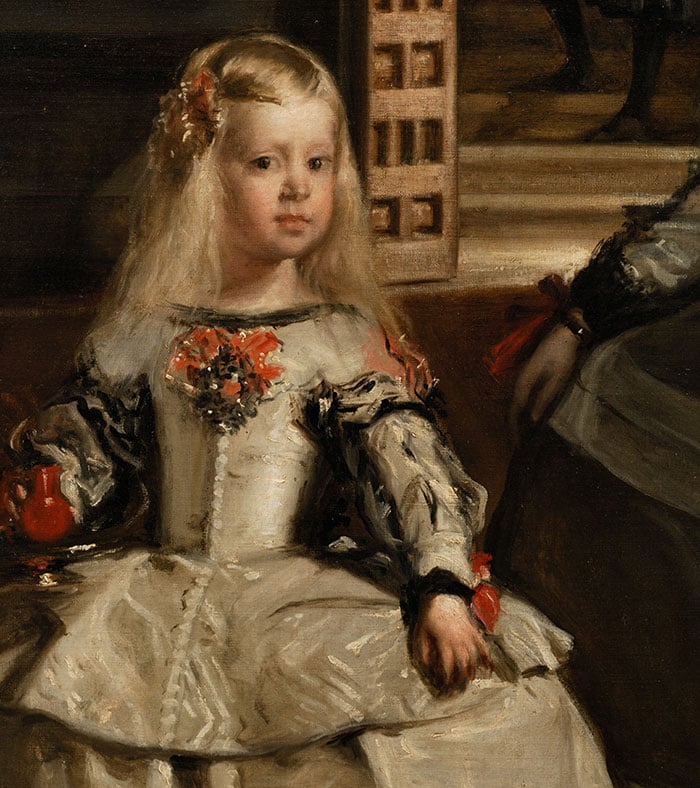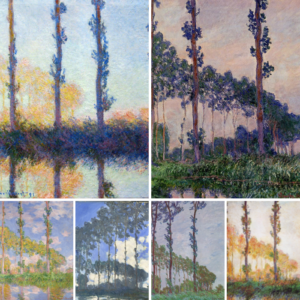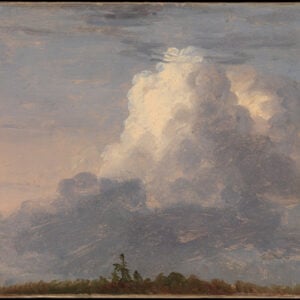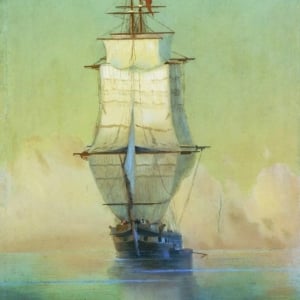In this post, I take a closer look at the remarkably sophisticated Las Meninas by Diego Velázquez. There is a lot of information surrounding this painting, but I will try and keep it simple.

I’ll cover:
- Key Facts and Ideas
- Composition
- Color and Light
- Brushwork and Technique
- Key Takeaways
- Sources and Additional Readings
- Want to Learn More?
- Thanks for Reading!
Key Facts and Ideas
Las Meninas has been the focus of scrupulous research and commentary. It has taken me hours to filter through all the “noise” and I don’t want to add to it.
So, here are some brief facts and ideas about the painting that I have personally found interesting. If you want to dive deeper, I suggest you take a look at some of the resources linked at the end of this post.
- The painting depicts a large room in the Royal Alcazar of Madrid, Spain.
- There are several figures in the painting, most notably Infanta Margaret Theresa, the daughter of King Philip IV of Spain. She is featured in several of Velázquez’s paintings, such as Infanta Margarita Teresa in a Blue Dress, shown below next to a close-up of her in Las Meninas.


- The other figures in the painting are listed here.
- Velázquez boldly included himself in the painting on the far left-hand side, standing brush-in-hand in front of a large canvas. His inclusion amongst royalty embodies his accomplishments as an artist. At the time he created Las Meninas, he had painted for the royal household for around 33 years.

- If you look in the mirror in the background, you can see the reflections of King Philip IV and Queen Mariana. Velázquez’s decision to depict the King and Queen in this way-blurry reflections in the background-is the topic of much speculation. Was Velázquez making a statement about their roles? About his role? Or maybe Velázquez is painting the King and Queen on his large canvas? There are no answers here, just questions to ponder (perhaps that was Velázquez’s intention).

- There are several interpretations of what Velázquez is painting on the large canvas. The most common seems to be that he is painting the King and Queen. Under this interpretation, we (the viewer) see the room from the perspective of the King and Queen as if we are being painted by the man himself. The other common interpretation is that the King and Queen are standing to the side, and Velazquez is painting what we see as Las Meninas. There is no concrete evidence either way, so you get to choose how you interpret it. Me? I see him painting the King and Queen.
- In 1734, Alcazar was destroyed by fire. Las Meninas was damaged in the fire but survived (500 other paintings were not so lucky). It was later restored and trimmed on both verticle sides.
Composition
This is a very sophisticated composition, with nine people, a dog, mirror reflections of the King and Queen, paintings on the wall, etc. Yet, there is a sense of organization and cohesion across it all.
The painting is large, coming in at 3.18 m by 2.76 m (I’m not sure if this is before or after it was damaged and trimmed). It has the dimensions of a portrait, but if you cut out the “quiet” top half, it has a distinct horizontal theme. So from a big picture standpoint, there is an interesting juxtaposition between the portrait dimensions of the painting and the horizontal theme within the painting.
There is also a pleasing sense of balance in the painting, with the “quiet” but large area balancing against the “busy” but relatively small area. This is even more evident in the grayscale image shown later in this post (Color and Light section).
As for the focal point, it appears to be the young girl, Infanta Margaret Theresa. Velázquez used some clever and subtle techniques to draw attention to her in such a busy scene:
- She is illuminated as she faces toward the main light source on the right-hand side of the painting. Most of the other figures are facing away from the light.
- There are several implied lines pointing in her direction (in yellow below). These are lines that do not physically exist but are merely suggested or implied. Leaning, motioning, looking or facing in a certain direction-these are implied lines.
- On the right-hand side of the painting, notice how most of the people and the dog are facing inwards. Infanta Margaret Theresa is the first to break this theme, creating a point of conflict or impact. (Composition is all about creating a sense of flow or expectancy, then making powerful statements by breaking it).

For the most part, light dictates where your eyes are drawn. But, I will leave that for the next section, Color and Light.
Now, let’s talk framing. To refresh your memory:
This painting features several frames: the frame of the room in which they are all standing; the frames of the paintings on the wall; the frame of the painting Velázquez is working on; the frame of the mirror; and the frame of the door in the background (refer to the image below).
These frames provide a strong linear and geometric theme to the painting; you get a feel of structure and organization. Then you have all these interesting, organic shapes created by the people and dog within this framed environment-a pleasant contrast between rigid and organic; straight and curved; stillness and movement.

Color and Light
There is a strong value contrast between the lights and darks. It reminds me of a less extreme version of the chiaroscuro technique used by the Old Masters.
As mentioned earlier, light seems to dictate your attention in the painting. Where the light goes, your eyes follow. Below is the painting in grayscale to give you a clear idea of the value structure:

In general, the colors are restrained, featuring mostly grays, browns, blacks, and other weak colors. But there are several vivid red accents scattered throughout the painting. These small bursts of color help draw your eyes around the painting towards key points of interest.
There is a feeling of warmth throughout the painting, with mostly red, orange, and yellow tones used (mirrored by the palette in Velázquez’s hand, below). The actual colors used by Velázquez were lead white, azurite, vermilion, red lake, ochres, carbon black. This is based on a study by Museo Prado in Madrid around 1981 (source).

In the background, you can see a man in the open doorway, coming or going. This is a small but powerful area, with a striking contrast between one of the lightest values next to one of the darkest values (refer to the grayscale image shown earlier). The use of hard edges in this area creates even more impact (hard edges-more clarity and impact).
Also, notice how in isolation, the focal point (the man) is dark and the background is light. This goes against the overarching theme of the painting as a whole, being dark background with light focal points. This creates a clever and subtle point of contrast.

Brushwork and Technique
The painting looks to have been done alla prima (wet-on-wet), which typically involves completing a painting within a single session whilst the paint is still wet. However, I doubt Velázquez-no matter how masterful he was-would have been able to complete a painting of such size and grandeur in just a single session. Smaller portraits, sure, but not Les Meninas.
I assume he would have worked on this over several sessions. This presents a logistical problem-how does one retain the “alla prima look” if the painting cannot be finished whilst the paint is still wet?
I can think of several approaches:
- You could segment the painting and allocate one painting session to each segment.
- You could get as much done as possible alla prima, then make touchups later, usually over dried paint.
- You could add a tiny amount of linseed oil over the dried paint, then work fresh paint over the top. This will feel similar to painting alla prima, but of course, there would be no mixing with the dried paint.
Whether or not Velázquez used any of these approaches, I’m not sure. If I had to guess, I would say he took the second approach-working as fast as possible alla prima, with touchups later.
My closer inspection of the painting suggests some use of scumbling, which is typically done over dried paint and would align with my assumption (see below, particularly around the hair). But again, I am just speculating.

From a big picture standpoint, the painting is beautifully rendered to a fine and delicate finish. But, as you look closer, you can see the confidence and looseness of his strokes. (It is always a big tick from me if a painting is both rendered to a fine finish and it looks like the artist had fun doing it).
Here are some other close-ups, starting with the delicate dresses and vivid red accents. Notice the glimmering highlights and deep black outlines. I get the sense Velázquez blocked-in the general colors and forms, then went over the top with illustrator-like details.

I wouldn’t be surprised if you missed these people altogether. The man, in particular, only just emerges from the dark shadows. It is amazing how much information Velázquez could capture with so little detail.

Finally, here is a close-up of the royal dog. Notice the painterly brushwork, soft edges, and simplified detail. This ensures the dog does not draw too much attention.

Key Takeaways
- For complex and sophisticated compositions, try painting on a larger scale. You will be able to “fit-in” more detail as needed.
- Some questions are best left unanswered. This will have people pondering over your art, like they do with Las Meninas.
- Think about how you can create an overarching theme or expectation, and how you can break it.
- Your focal point doesn’t need to “shock-and-awe”. It just needs to have more impact than other areas in the painting. Take advantage of subtle techniques to draw attention towards the focal point, like the implied lines used in this painting.
- Framing is a powerful technique for containing attention within certain areas and for creating a sense of structure.
- Our eyes are very sensitive to changes in light. Use that to your advantage.
- Working alla prima on such a large scale presents a logistical problem of being unable to finish the painting within a single session whilst the paint is still wet. I provided three approaches to combat this.
Sources and Additional Readings
Wikipedia – Las Meninas (You can also download a VERY large photo of the painting. It literally crashed my computer several times; it is that large. Download it for yourself so you can “zoom-in” on the detail).
Examining Velazquez by Gridley McKim-Smith, Greta Andersen-Bergdoll, and Richard Newman
Velázquez (Complete Works) by José López-Rey and Odile Delenda
A Closer Look at Portrait of Madame X by John Singer Sargent
A Closer Look at The Milkmaid by Johannes Vermeer
Want to Learn More?
You might be interested in my Painting Academy course. I’ll walk you through the time-tested fundamentals of painting. It’s perfect for absolute beginner to intermediate painters.
Thanks for Reading!
I appreciate you taking the time to read this post and I hope you found it helpful. Feel free to share it with friends.
Happy painting!
Dan Scott

Draw Paint Academy







Excelent!!
One of my favorite. It inspired me to do my “Self Portrait”.
If I could attach it here I would but it will have to wait for another day.
Thank you for doing the research .
I’ve read “Velasquez the art of painting” by Madelyn Millner Kahr.
It covers a lot of the history of the painting.
Frank
Wow! How wonderful analysis Dan. I love this painting but never before went to undeservedly so many aspects of it. It is amazing how much information was Velazquez able to put in it. Such beautiful piece of art!
Always a very informative deconstruction of an artist’s work highlighting elements for both appreciation and painting instruction. Love your work.
Excellent article. Always enjoy your take! Thanks
BRAVO – EVGE in Greek
VERY INFORMATIVE AND DETAILED
Gregory Kokkoris
Great insight. Also very informative history lesson. Thanks
Extra ordinary effort in describing the details with intensive observation , followed by appropriate suggestions. Thanks a lot, keep up the good work.
Extra ordinary effort in describing the details with intensive observation , followed by appropriate suggestions. Thanks a lot, keep up the good work.
I really enjoyed your critique of this painting. Very informative. Thank you!
The color subtleties of browns and shades of gray that dominate this painting are impressive and it may be dictated by sophisticated royal culture of understatement, which the painter would know very well if he painted for thirty three years for the king. But we live in a period of unabashed hyperbole as the normal mode of expression. ‘awesome’ for beautiful, ‘absolutely’ for yes, ‘incredible’ for good. Do you think this degree of subtlety can be appreciated today, keeping in mind that the audience of today are a far cry from royalty?
Lol. Other words…you got that right.
You can say that again!
In the Barcelona Picasso museum, I also saw the many paintings Picasso did based on this masterpiece. Really fascinating! Spain is a treasure trove of incredible art! Thanks for reminding me of both artists!
Very informative and interesting … great read and insight, thanks!
Thank you for all the work and effort you did, to bring us such helpful insight to an apparent master. We can take much away from this study.
Dan, thank you for sharing your insights and analysis of Las Meninas. You highlight Velasquez’ extraordinary sensitivity to light. Amazing! Once again thank you.
I have no problems whit the speculation if it was painted alla prima or not. Zorn who was a great admire of Velazquez used yellow ochre and black for a imprimatur and then continue to paint all over the surface beginning whit the dark shadows and then continued to raise the colors to the optimal light. If you look in the shadows you can se the imprimatur just the way he left it.
Thanks for posting! I just saw a documentary on Velazquez on YouTube, so this really piqued my interest. Very informative post, thanks for sharing!
I wonder as far as who was included in the composition…Is it possible the parents simply asked the little girl who she wanted in the painting? You can see by how much she’s doted on in the painting that it wouldn’t be much of a reach. Wouldn’t it be hilarious if centuries of speculation as to why Velazquez included who he did [including himself, the parents in a mirror, and the pooch] boiled down to a little girl’s wishes? ; )
Hello! Here’s is a little info for you: This painting’s other name is La Familia-The Family. Spanish Habsburgs were very strictly observing social hierarchy. All of these people gathered around the Infanta, who would be the only daughter of 12 children to survive to adulthood, they are all high ranking nobles. Here is additional information: In the foreground of the painting we can see the princess’s maids of honor: the two aristocratic young ladies Isabel de Velasco and María Agustina Sarmiento de Sotomayor. In the right foreground, two servant dwarfs are shown, with the tallest one looking directly at the viewer. The female dwarf, known as María Bárbara Asquín was originally of German noble family and was the princess’s main chambermaid, she always accompanied her wherever she went: with water, food, and other necessities. The smaller, younger dwarf, who touches the dog with his foot, was an Italian noble, Nicolasito Pertusato, who became later the King\’s main chamber servant. The woman behind the maids of honor was the princess´s main nanny, Marcela de Ulloa. She was married to the Ducal family de Uolla, the Grands of Spain, 1st class, since 1520. Although she was a widow, I found that she spent time in a convent, as noblewomen used to do she was engaged in Royal court. I suspect she wears the nun’s habit here. She is depicted talking to Diego Ruiz de Azcona, a Basque prelate of a noble family who was Bishop of Pamplona Archbishop of Burgos. Person very appreciated by Velázquez who would later be the executor of his will.The man standing in the door opening is José Nieto Velázquez, the queen’s main chamberlain during the 1650s and back then head of the royal tapestry works, who also may have been a relative of Diego Velazquez himself. <There. I hope you'll enjoy my findings as much as I loved researching them. Have a great weekend! Elizabeth
Thank you Dan ,very interesting. Enjoyed it you do a lot of interesting facts
Thank you again for a wonderful article. I would not have been able to discern so much information as yours.
Thank you for your wonderful analysis. I found it extremely informative.
Helping us study the paintings through these art history pointers certainly improves my ability to make sense of the various techniques and style intricacies and such needed to create a successful painting, one that achieves my particular goals. Thank you for the wonderful insights.
Very interesting! Thank you for your insight.
Many thanks.Another educative art article.
Excellent analysis. For my untrained eye, I see the man at the door, with the brilliant contrast between white and dark as a central theme of the picture. Here we have a traditional scene, everyone doting on the little blond princess, no one noticing the interloper observing, intruding, perhaps about to disturb the scene. My eye went straight to the man in the door, juxtaposed against the young princess. The timeframe of the painting saw much social unrest in Europe, with the French Revolution and the American Revolution brewing. Perhaps those themes are an undercurrent here?
The painting is large, coming in at 3.18 m by 2.76 m (I’m not sure if this is before or after it was damaged and trimmed)… Those are the dimensions after the trim, as the painting exists today.
Great insights about the piece. I would love to see the preparatory sketches for this as it must have taken a while to compose and figure out all the nuances.
Excellent analysis. I love your comments.
Thank you. Very informative and interesting!
Love these reviews! Your reviews remind me of my favorite teacher in High School, Mrs. Madsen. She taught my history class and was the music teacher as well. She spent her summers traveling in foreign countries, sitting in on sessions at the United Nations. I believe she had visited every museum there ever was. She read historical publications that told of details a bit too brazen to be in our public educational books back then. What a gift she was! I wanted to listen to her all day. She shared with us all that accumulated knowledge, even some of the seedy details. 🙂 She passed away a couple of years ago at the full age of 104. (I am now 75 years old. How did that happen so quickly?) I was so privileged to have known her. Thank you for your time and efforts to educate us! A big key to living is to never stop learning. 🙂
Excellent analysis! I love your articles.
I really appreciate your analysis of each artist you research. Keep posting! This is better than the art history classes I’ve taken at University.
Thank you. No one ever taught me such detailed info. You are very generous thanks agakn
Great artical
Read “Velazquez” by Jonathan Brown, a 300+ page large format comprehensive book with analysis of his painting techniques.
For one who never took art history. I find these articles enlightening to the max. Thank you for doing this.
For one who never took art history. I find these articles enlightening to the max. Thank you for doing this.